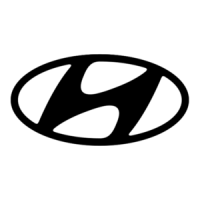2-32
Safety system of your vehicle
Rearward-facing Child Restraint
System
A rearward-facing Child Restraint
System provides restraint with the
seating surface against the back of
the child. The harness system holds
the child in place, and in an accident,
acts to keep the child positioned in
the Child Restraint System and
reduce the stress to the fragile neck
and spinal cord.
All children under the age of one year
must always ride in a rearward-facing
Child Restraint System. There are dif-
ferent types of rearward-facing Child
Restraint Systems: infant-only Child
Restraint Systems can only be used
rearward-facing. Convertible and 3-in-
1 Child Restraint Systems typically
have higher height and weight limits
for the rearward-facing position, allow-
ing you to keep your child rearward-
facing for a longer period of time.
Keep using Child Restraint Systems
in the rearward-facing position as
long as children fit within the height
and weight limits allowed by the Child
Restraint System's manufacturer. It’s
the best way to keep them safe. Once
your child has outgrown the rearward-
facing Child Restraint System, your
child is ready for a forward-facing
Child Restraint System with a har-
ness.
Forward-facing Child Restraint
System
A forward-facing Child Restraint
System provides restraint for the
child’s body with a harness. Keep chil-
dren in a forward-facing Child
Restraint System with a harness until
they reach the top height or weight limit
allowed by your Child Restraint
System’s manufacturer.
Once your child outgrows the forward-
facing Child Restraint System, your
child is ready for a booster seat.
OGB034031OLMB033041

